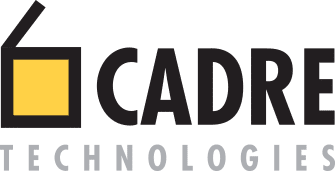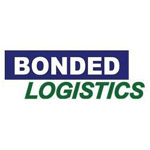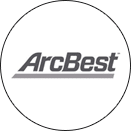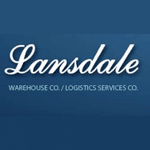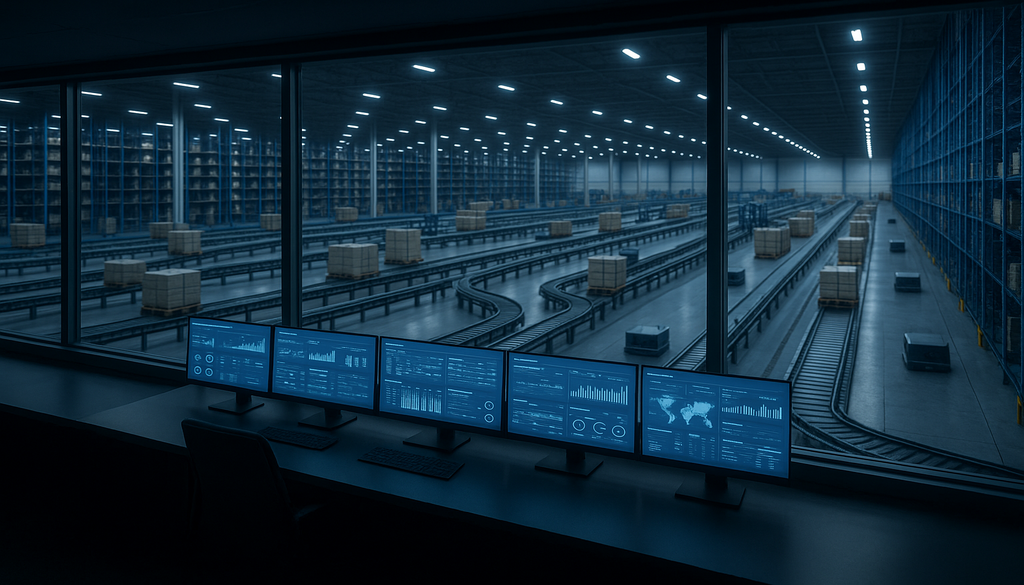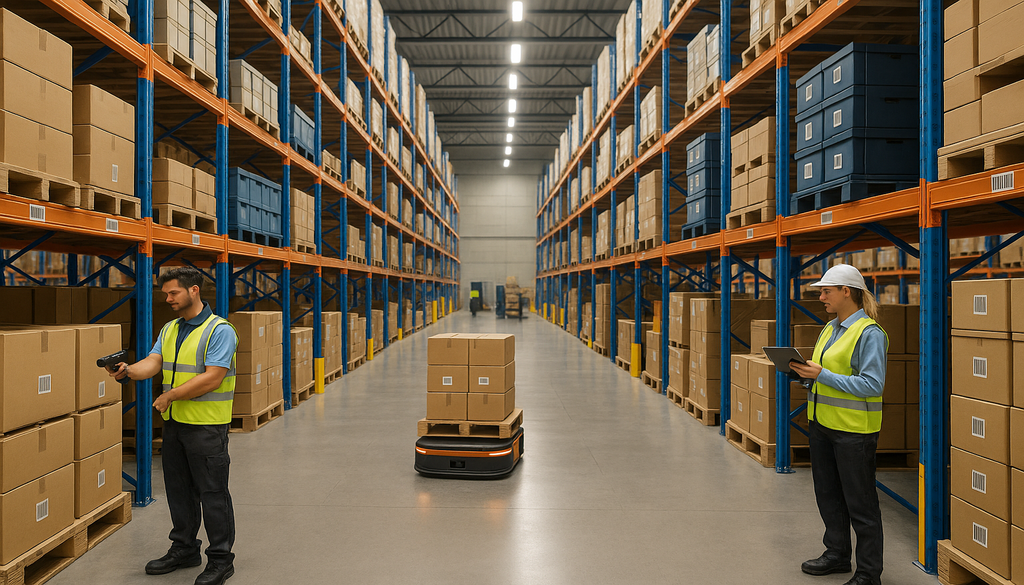What Are 3PL and 4PL? Definitions and Key Differences
In today’s rapidly evolving supply chain landscape, businesses are increasingly turning to external logistics providers to optimize their operations. The distinction between 3PL vs 4PL logistics providers represents a critical decision point for companies seeking to enhance their supply chain efficiency. Third-party logistics (3PL) and fourth-party logistics (4PL) providers offer different levels of service, integration, and strategic involvement in your business operations. Understanding these differences is essential for making informed decisions that align with your company’s logistics needs, growth trajectory, and long-term business objectives.
Third-party logistics (3PL) providers deliver specific operational logistics services such as transportation, warehousing, inventory management, and distribution. These providers function as extensions of your logistics department, handling the physical movement and storage of goods while providing specialized expertise in specific logistics functions. The relationship with a 3PL typically operates on a transactional basis, with services clearly defined and measured against specific performance metrics. Most businesses begin their outsourcing journey with 3PL providers to address particular pain points or capacity issues in their logistics operations.
Fourth-party logistics (4PL), by contrast, represents a more comprehensive approach where the provider takes responsibility for managing your entire supply chain. A 4PL provider orchestrates all logistics activities, including overseeing 3PL providers, transportation carriers, and other supply chain vendors. This model emphasizes strategic oversight, continuous optimization, and technology integration rather than merely executing logistics functions. The 4PL acts as a supply chain integrator that assembles and manages the resources, capabilities, and technologies across the organization to deliver a comprehensive supply chain solution. This relationship is typically characterized by deeper integration, shared objectives, and a more collaborative approach to supply chain management.
The fundamental difference between 3PL and 4PL lies in their scope of responsibility and strategic involvement. While 3PLs focus on operational execution within specific logistics functions, 4PLs take a holistic view of the entire supply chain ecosystem. 3PLs provide tactical support with physical assets and operational expertise, whereas 4PLs deliver strategic oversight, technology integration, and continuous optimization across all logistics activities. The decision between these models depends on your organization’s needs for control, expertise, technology capabilities, and long-term supply chain vision.
Analyzing the Benefits of 3PL Providers
Partnering with a third-party logistics provider offers numerous advantages for businesses looking to optimize their supply chain operations without surrendering complete control. The most immediate benefit is cost reduction through economies of scale that 3PLs achieve by spreading fixed costs across multiple clients. These providers eliminate the need for significant capital investments in warehouses, transportation fleets, and logistics technology, converting fixed costs to variable expenses that scale with your business needs. Additionally, 3PLs offer specialized expertise in regulatory compliance, customs procedures, and regional logistics nuances that would be costly and time-consuming to develop in-house. This combination of cost efficiency and specialized knowledge creates a compelling value proposition for businesses of all sizes.
The operational expertise that 3PL providers bring to the table cannot be overstated. These logistics specialists have developed refined processes through years of experience across multiple industries and client scenarios. Their teams understand the intricacies of transportation management, warehouse optimization, inventory control, and distribution planning—knowledge that translates into measurable improvements in service levels and operational performance. Many 3PLs also maintain relationships with carriers and suppliers that allow them to negotiate favorable rates and priority service that would be unavailable to individual businesses. This expertise extends to technology implementation, where 3PLs often deploy sophisticated warehouse management systems (WMS), transportation management systems (TMS), and visibility platforms that enhance operational efficiency and provide real-time insights into supply chain performance.
Perhaps the most valuable benefit of working with 3PL providers is the scalability and flexibility they offer to growing businesses. During peak seasons or periods of rapid growth, 3PLs can quickly allocate additional resources—warehouse space, labor, transportation capacity—without requiring long-term commitments. Conversely, during slower periods, businesses can scale down their logistics operations without the burden of underutilized assets or excess personnel. This flexibility enables businesses to respond more effectively to market changes, seasonal fluctuations, and unexpected disruptions. Moreover, the geographic reach of established 3PLs allows businesses to expand into new markets without establishing physical infrastructure, significantly reducing the risk and investment typically associated with market expansion.
For businesses with international operations, 3PLs provide invaluable support in navigating complex cross-border logistics challenges. They maintain expertise in international shipping documentation, customs clearance procedures, duties and taxes, and compliance with country-specific regulations. This knowledge helps businesses avoid costly delays, penalties, and customer service failures when shipping internationally. Additionally, established 3PLs often maintain networks of warehouses and distribution centers in key global markets, allowing businesses to position inventory closer to international customers without investing in overseas facilities. The combination of international expertise and established infrastructure significantly reduces the barriers to global expansion.
The Advantages of Opting for 4PL Providers

Fourth-party logistics providers deliver unparalleled supply chain oversight by functioning as the single point of accountability for all logistics operations. Unlike 3PLs that focus on executing specific functions, 4PLs take responsibility for designing, building, running, and measuring integrated supply chain solutions. This comprehensive approach enables businesses to consolidate their logistics management through a single strategic partner rather than managing multiple service providers. The 4PL model creates alignment across all supply chain activities, eliminating silos and optimizing the entire logistics ecosystem as a unified system. This holistic perspective allows 4PLs to identify inefficiencies and improvement opportunities that might remain hidden when logistics functions are managed separately. For organizations with complex, multi-faceted supply chains, this integrated management approach drives significant value through enhanced coordination and strategic alignment.
Technology integration represents one of the most compelling advantages of working with 4PL providers. These advanced logistics partners deploy sophisticated technology stacks that connect all elements of the supply chain—from procurement and manufacturing to warehousing and last-mile delivery. By implementing end-to-end visibility platforms, 4PLs provide real-time insights into inventory positions, order status, transportation movements, and delivery performance across the entire network. This technological capability enables data-driven decision-making based on comprehensive analytics rather than fragmented information from disparate systems. Furthermore, 4PLs often leverage advanced technologies like artificial intelligence, machine learning, and predictive analytics to anticipate disruptions, optimize routing, and enhance inventory positioning. This technological sophistication would require significant investment to develop internally, making 4PLs an attractive option for businesses seeking state-of-the-art supply chain capabilities.
The strategic value that 4PLs deliver extends beyond day-to-day logistics execution to include continuous improvement and long-term planning. These providers conduct regular network optimization studies, scenario planning exercises, and capability assessments to ensure the supply chain remains aligned with evolving business objectives. Unlike tactical 3PL relationships that focus on meeting predetermined service levels, 4PL partnerships emphasize continuous evolution of the logistics network to enhance competitive advantage. This strategic orientation includes developing capabilities to support new product launches, market expansions, and business model changes that require supply chain adaptations. By functioning as strategic advisors rather than just service providers, 4PLs help businesses anticipate market shifts and proactively adjust their supply chain strategies to maintain competitive advantage.
Another significant benefit of the 4PL model is the provider’s ability to leverage its broader network and relationships to secure optimal service and pricing. 4PLs typically manage substantial logistics volumes across multiple clients, giving them significant negotiating power with carriers, warehouse operators, and technology providers. This scale allows them to secure preferential rates, capacity commitments, and service levels that individual businesses might not achieve independently. Additionally, 4PLs maintain relationships with specialized logistics providers across different regions, modes, and service categories, allowing them to assemble the optimal mix of partners for each client’s unique requirements. This “best-of-breed” approach ensures that businesses benefit from leading capabilities in each logistics function rather than settling for the limited service portfolio of a single provider.
How to Decide: Choosing Between 3PL and 4PL for Your Business
The decision between 3PL and 4PL solutions should begin with a thorough assessment of your organization’s strategic objectives and logistics requirements. Consider how your supply chain supports your competitive positioning in the market—whether through cost leadership, service differentiation, or product innovation. Organizations primarily focused on cost efficiency might benefit from 3PL relationships that deliver operational improvements in specific functions without the overhead of full supply chain transformation. Conversely, businesses competing on service excellence or agility might find greater value in the comprehensive capabilities of a 4PL provider that can orchestrate seamless end-to-end logistics experiences. Your growth trajectory also plays a crucial role in this decision, as rapidly expanding businesses or those entering new markets might benefit from the scalable infrastructure and global capabilities that 4PLs provide, while stable businesses might find adequate support through targeted 3PL partnerships.
Company size and operational complexity significantly influence the appropriate logistics partnership model. Small to medium-sized businesses with straightforward supply chains typically benefit from 3PL relationships that address specific operational needs without requiring extensive integration or substantial management overhead. These companies often lack the transaction volume and complexity that would justify a comprehensive 4PL engagement. Larger enterprises with multi-channel distribution networks, global sourcing, and complex customer requirements frequently find greater value in the 4PL model, which provides the coordination capabilities and technological infrastructure to manage intricate supply chain ecosystems. Industry characteristics also shape this decision—sectors with highly specialized logistics requirements like pharmaceuticals, aerospace, or hazardous materials might benefit from the focused expertise of 3PLs, while industries undergoing rapid digital transformation might require the technological capabilities and change management expertise of 4PLs.
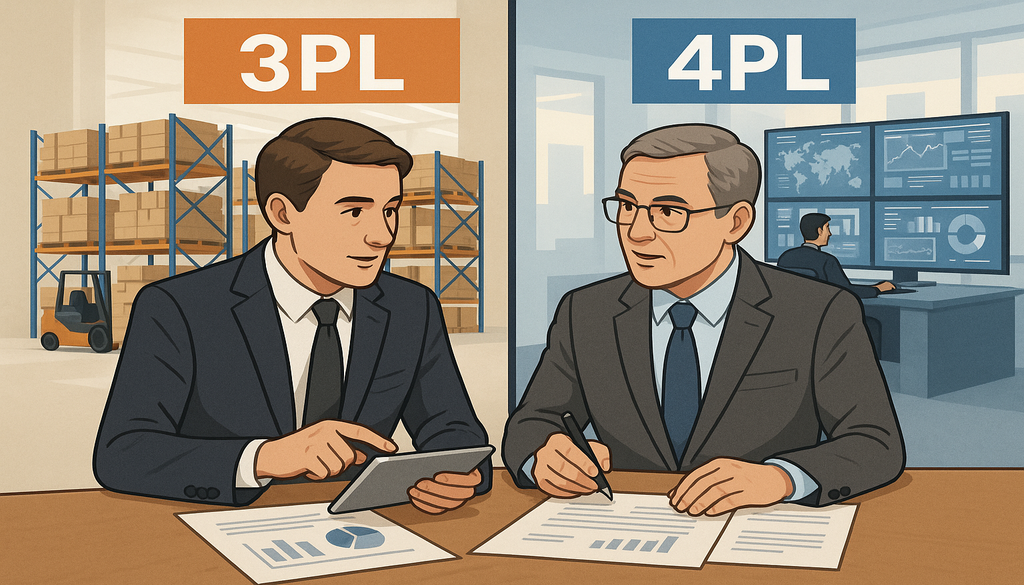
The desired level of control and internal logistics capabilities represents another critical factor in choosing between 3PL and 4PL models. Organizations that maintain strong internal supply chain teams with established processes and systems might prefer 3PL partnerships that complement existing capabilities without disrupting established governance structures. These businesses often value maintaining strategic control while outsourcing specific operational functions to specialized providers. Conversely, companies looking to transform their supply chain capabilities or those with limited internal logistics expertise might benefit from the comprehensive management approach of a 4PL provider. This model allows businesses to leverage external expertise while focusing internal resources on core competencies like product development, marketing, or customer relationship management.
Financial considerations naturally play a significant role in logistics outsourcing decisions. The 3PL model typically involves more straightforward cost structures with transaction-based pricing tied to specific activities like warehousing space, labor hours, or transportation moves. This approach offers predictability and clear ROI measurement for targeted logistics functions. The 4PL model generally requires greater financial commitment, with pricing structures that might include management fees, gain-sharing mechanisms, and transformation costs. However, for organizations with complex supply chains, the total cost of ownership often favors the 4PL approach when considering the eliminated overhead of managing multiple providers, technology investments, and continuous optimization capabilities. The financial evaluation should consider both immediate cost impacts and long-term value creation through improved supply chain performance, reduced risk, and enhanced agility.
Real-World Applications: 3PL vs 4PL in Different Industries
The retail sector provides illuminating examples of both 3PL and 4PL applications tailored to different business models and market positions. Traditional brick-and-mortar retailers often partner with 3PLs for specific functions like store replenishment, seasonal warehousing, or returns processing. This targeted approach allows them to address particular pain points without disrupting established supply chain operations. For instance, a regional department store chain might engage a 3PL to manage its e-commerce fulfillment operation while maintaining direct control over store distribution. In contrast, omnichannel retailers with complex inventory management requirements increasingly adopt the 4PL model to orchestrate seamless inventory flows across multiple channels. A leading fashion retailer implemented a 4PL solution that unified inventory visibility across stores, distribution centers, and fulfillment locations, enabling capabilities like ship-from-store and endless aisle that significantly improved customer experience and inventory productivity. The retailer’s decision to pursue a 4PL relationship stemmed from the need to coordinate multiple logistics providers and technologies under a unified strategy.
Manufacturing companies demonstrate different approaches to logistics outsourcing based on their production models and market requirements. Discrete manufacturers often utilize 3PLs for inbound logistics, managing the flow of components and raw materials to production facilities while maintaining internal control of production-related logistics. A major automotive manufacturer partners with regional 3PLs to manage just-in-time deliveries to assembly plants, focusing on reliability and precise scheduling rather than comprehensive supply chain transformation. Process manufacturers, particularly those with global operations, frequently adopt 4PL models to orchestrate complex networks of raw material sourcing, production planning, and finished goods distribution. A leading consumer packaged goods company implemented a 4PL solution that integrated production scheduling with logistics execution across multiple continents, significantly reducing inventory carrying costs while maintaining high service levels. This approach allowed the manufacturer to focus on product innovation and brand building while leveraging external expertise for supply chain execution.
The e-commerce sector presents perhaps the clearest contrast between 3PL and 4PL applications based on business scale and maturity. Early-stage e-commerce companies typically begin with 3PL relationships focused on warehousing and order fulfillment, allowing them to scale operations without significant capital investment. A growing direct-to-consumer brand partnered with a specialized e-commerce 3PL to manage its fulfillment operations, benefiting from the provider’s expertise in picking, packing, and shipping individual orders. As e-commerce businesses mature and expand into multiple markets, many transition toward the 4PL model to manage increasingly complex logistics networks. A global online marketplace implemented a 4PL solution to orchestrate its extensive network of fulfillment centers, cross-dock facilities, and last-mile delivery providers. This approach enabled consistent service levels across diverse markets while optimizing the total cost to serve through dynamic inventory positioning and transportation mode selection.
Healthcare and pharmaceutical companies demonstrate how industry-specific requirements influence the choice between 3PL and 4PL models. Organizations in these highly regulated industries often begin with specialized 3PLs that maintain expertise in temperature-controlled storage, lot tracking, and regulatory compliance. A pharmaceutical manufacturer partnered with a healthcare-focused 3PL to manage distribution of temperature-sensitive medications, leveraging the provider’s validated facilities and established quality management systems. As healthcare supply chains become more patient-centric and digitally enabled, some organizations are transitioning toward 4PL models that integrate product flow with information management. A leading medical device company implemented a 4PL solution that connected manufacturing, distribution, and hospital inventory management systems, creating visibility from production to patient use. This integrated approach improved product availability while reducing emergency shipments and excess inventory throughout the supply chain.
Future Trends in 3PL and 4PL Logistics Solutions
Technological advancement represents the most significant force reshaping both 3PL and 4PL service offerings. Artificial intelligence and machine learning are transforming logistics planning and execution through predictive analytics that anticipate disruptions, optimize inventory positioning, and enhance transportation routing. These technologies are enabling a shift from reactive to proactive supply chain management, with logistics providers developing capabilities to address potential issues before they impact operations. The Internet of Things (IoT) is creating unprecedented visibility through connected assets that report location, condition, and environmental factors in real-time. Blockchain technology is improving supply chain transparency and security through immutable record-keeping for critical transactions and product movements. For 3PL providers, these technologies enhance operational efficiency and service quality within their specific functions. For 4PLs, advanced technologies enable more sophisticated orchestration across the entire supply chain ecosystem, creating integrated platforms that connect planning, execution, and analytics in real-time.
The convergence of physical and digital supply chains is creating new opportunities and challenges for logistics providers across the spectrum. E-commerce growth has accelerated the need for seamless integration between digital storefronts and physical fulfillment operations, with logistics providers developing specialized capabilities for omnichannel fulfillment, parcel optimization, and returns management. The rise of digital marketplaces is creating new distribution models that require flexible logistics networks capable of supporting diverse seller requirements and customer expectations. For 3PLs, this trend is driving specialization in e-commerce fulfillment, last-mile delivery, and reverse logistics. For 4PLs, the convergence is creating opportunities to develop integrated platforms that connect digital commerce with physical logistics through unified data models and process workflows. Leading providers are establishing capabilities that transcend traditional boundaries between digital and physical operations, creating seamless experiences for both businesses and consumers.
Sustainability requirements are increasingly influencing logistics outsourcing decisions as businesses face growing pressure to reduce environmental impacts throughout their supply chains. Logistics providers are developing capabilities for carbon footprint measurement, alternative fuel transportation, packaging optimization, and circular economy solutions. For 3PLs, sustainability initiatives often focus on operational improvements like fleet electrification, energy-efficient warehouses, and waste reduction programs. For 4PLs, sustainability represents a strategic imperative that extends across the entire supply chain, including network design, mode selection, carrier management, and performance measurement. Forward-thinking providers are integrating environmental considerations into their core service offerings, helping clients achieve sustainability objectives while maintaining operational performance. The ability to support corporate environmental goals is becoming a significant differentiator in logistics provider selection, with both 3PLs and 4PLs enhancing their capabilities in this area.
The logistics provider landscape itself is evolving through consolidation, specialization, and new business models. Traditional boundaries between 3PLs and 4PLs are blurring as providers expand their capabilities and service offerings. Many established 3PLs are developing 4PL capabilities to capture more strategic relationships and higher-margin services. Technology companies are entering the logistics space with digital platforms that connect shippers with service providers, creating new competitive dynamics. This evolution is creating both opportunities and challenges for businesses as they navigate an increasingly complex provider ecosystem. The most successful logistics partnerships will likely involve thoughtful provider selection based on specific business requirements, cultural alignment, and long-term strategic fit rather than rigid adherence to traditional 3PL or 4PL definitions. Organizations that develop clear logistics outsourcing strategies aligned with their business objectives will be best positioned to leverage the evolving capabilities of logistics service providers.
Conclusion
The decision between 3PL and 4PL logistics solutions represents a strategic choice that can significantly impact your business’s operational efficiency, cost structure, and competitive positioning. Throughout this exploration of 3PL vs 4PL logistics models, we’ve examined how each approach offers distinct advantages depending on your organization’s size, complexity, growth trajectory, and strategic objectives. The 3PL model delivers specialized expertise and operational excellence in specific logistics functions, providing cost-effective solutions for businesses with defined needs and existing supply chain capabilities. Conversely, the 4PL approach offers comprehensive supply chain orchestration, technology integration, and strategic partnership for organizations seeking transformative improvements across their entire logistics ecosystem.
As supply chains continue to increase in complexity and strategic importance, the distinctions between these models will remain crucial for business leaders to understand and evaluate. The optimal approach for your organization will depend on a thoughtful assessment of your current capabilities, future requirements, and desired level of control over logistics operations. Whether you choose a targeted 3PL partnership or a comprehensive 4PL relationship, success will ultimately depend on clear alignment between your business objectives and your logistics strategy. By understanding the fundamental differences between 3PL and 4PL providers, you can make informed decisions that position your supply chain as a source of competitive advantage in an increasingly dynamic business environment.
Frequently Asked Questions (FAQ)
Q1: What are the key factors to consider when choosing between 3PL and 4PL providers?
When selecting between 3PL and 4PL providers, businesses should evaluate their specific needs for control over the supply chain, the complexity of their logistics requirements, the level of expertise needed, and their budget constraints. 3PL is typically suited for companies looking for execution within certain parts of their logistics, while 4PL offers a more integrated solution managing the entire supply chain process. Additionally, consider your organization’s growth trajectory, technological capabilities, and strategic priorities. Businesses with straightforward logistics needs often benefit from 3PL relationships, while those with complex, multi-channel operations may find greater value in the comprehensive orchestration that 4PLs provide. Assessing these factors can guide businesses to the most appropriate logistics partnership.
